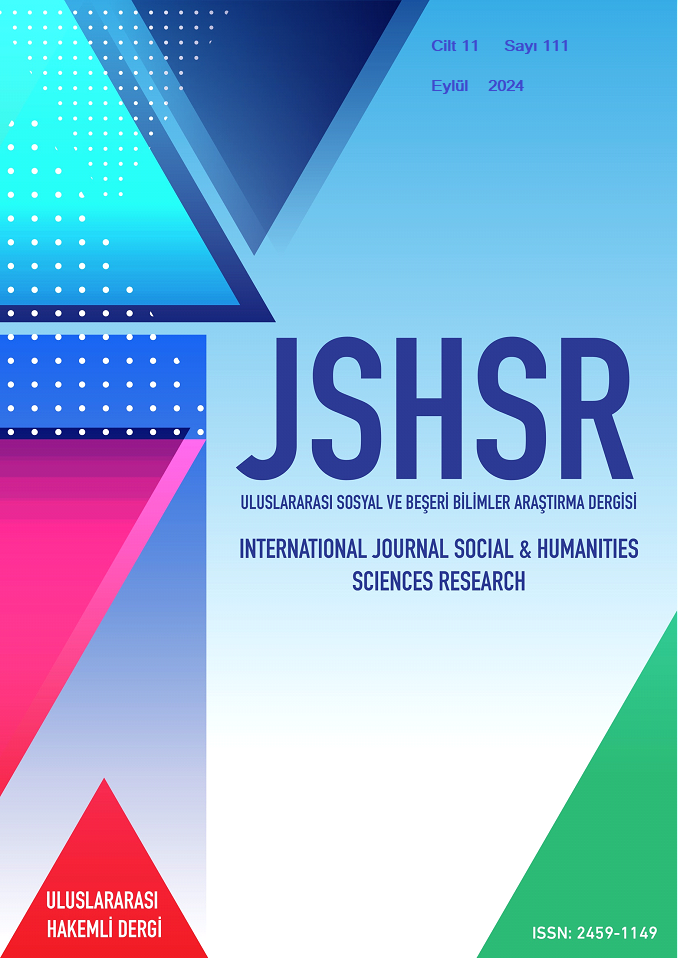Transforming Woven Design Samples into Clothing-Accessories-Home Textile Products within the Scope of Sustainability
DOI:
https://doi.org/10.5281/zenodo.13864121Keywords:
weaving, clothing, sustainability, design, textileAbstract
Weaving, one of the subfields of fashion, is a fabric production method that involves interlacing warp and weft yarns at right angles according to a predetermined pattern or motif. Many different weaving designs for the intended use can be made by using different derivatives and components of basic weaves (plain, twill, satin) or by developing original weave types.
In this study, weaving design samples created as course outcomes by students in the Weaving Design classes at the Department of Textile and Fashion Design, Faculty of Fine Arts, Çukurova University, have been transformed into clothing and home textile designs using upcycling and mending approaches. For this purpose, weaving design samples that were not taken back by students and had surpassed their archival period, along with waste primary and auxiliary materials donated by textile companies, were used to design blouses, sweaters, crop tops, corsets, sashes, tote bags, jabots, necklaces, pillows, placemats, and runners. In today’s world, where sustainability has become increasingly important, the idea of repurposing even the smallest pieces through recycling, upcycling, mending, and reuse techniques constitutes the first step in spreading such practices from the individual to the universal.
As a result of the study, suggestions were made to ensure that textile design samples and unused materials taken from textile firms are recycled instead of leaving them as waste in nature, to draw attention to sustainability and green economy, which are among the important issues of our day, and to contribute to the “zero waste” principle that should be adopted by society. Keywords: Weaving, clothing, sustainability, design, textile.
References
Aakko, M., & Koskennurmi-Sivonen, R. (2013). Sustainable fashion design: possibilities and challenges. Research Journal of Textile and Apparel, 17(1), 13-22. doi:https://doi.org/10.1108/RJTA-17-01-2013-B002.
Birtwistle, G., & Moore, C. M. (2007). Fashion clothing - Where does it all end up? International Journal of Retail and Distribution Management, 35(3), 210-216. doi: 10.1108/09590550710735068.
Brown, S. (2010). Eco fashion. Laurance King Publishing.
Carey, L. & Cervellon, M., C. (2014). Ethical fashion dimensions: pictorial and auditory depictions through three cultural perspectives. Journal of Fashion Marketing and Management: An International Journal, 18(4), 483-506. https://doi.org/10.1108/JFMM-11-2012-0067.
Charpail, M. (2017, Ocak 4). What’s wrong with the fashion industry? https://www.sustainyourstyle.org/ en/whats-wrong-with-the-fashion-industry#anchor-environmental-impact.
Çoruh, E., Kalebek, A. N., Özdemir, G. & Öztürk, T. (2019). Dokuma kumaş tasarımı ve örnek uygulamaları. İdil, (63), 1603-1609.
Coşkun, Y., & Coşkun E. A. (2022). Döngüsel ekonomi ve sürdürülebilirlik. Bilim ve Teknik Dergisi, 55(651), 52-59. https://bilimteknik.tubitak.gov.tr/makale/dongusel-ekonomi-ve-surdurulebilirlik.
Davies, I., McDonagh, P., & Glozer, S. (2020). Sustainable fashion: current and future research directions. European Journal of Marketing, 54(11), 2873-2909. https://doi.org/10.1108/EJM-02-2019-0132.
European Comission Report. (2014). Towards a circular economy: A zero waste programme for Europe. Brussels, pp. 2, 2.7.2014 COM 398 final. [Online]. http://ec.europa.eu/environment/circular-economy/pdf/circulareconomy-communication.pdf
Gürcüm, B.H. (2005). Tekstil malzeme bilgisi. Grafiker Ofset.
Henninger, C.E., Alevizou, P.J. & Oates, C.J. (2016) What is sustainable fashion?. Journal of Fashion Marketing and Management. 20(4), 400-416. https://doi.org/10.1108/JFMM-07-2015-0052.
Janigo, K. A., Wu, J., & DeLong, M. (2017). Redesigning fashion: An analysis and categorization of women’s clothing upcycling behavior. Fashion Practice, 9(2), 254-279.
Joergens, C. (2006). Ethical fashion: myth or future trend?. Journal of Fashion Marketing and Management, 10(3), 360-371. doi: 10.1108/13612020610679321
Keleş, Ö. & Yılmaz, E. (2022). Dokuma teknolojileri ve uygulamaları. İksad Yayınları.
Kirpalani, N. (2022). Sustainability in the fashion Industry: A business perspective. Anna Maria Loffredo, Rainer Wenrich, Charlotte Axelsson & Wanja Kröger, (Eds.) Changing time-shaping world içinde (s. 231-243). https://doi.org/10.1515/9783839461358-013
Köse, Ş. G., & Aydın, K. (2020). Sürdürülebilir Moda Perakendeciliği: Tüketici Algıları Üzerine Bir Araştırma. Istanbul Business Research, 49(1), 86-116. https://doi.org/10.26650/ibr.2020.49.0099
McDonough, W. & Braungart, M. (2010). Cradle to cradle: Remaking the way we make things. North point press.
Metlioğlu H. H. (2012). Tekstil tasarım eğitiminde sinema temalı dokuma kumaş tasarımı, İnönü Üniversitesi Sanat ve Tasarım Dergisi, 2(5), 177-186.
Metlioğlu H. H. (2015). Dokuma kumaş tasarımında yaratıcılık için bir yöntem önerisi, Yedi, (13), 41-50. https://doi.org/10.17484/yedi.14285.
Niinimäki, K. (2013). Sustainable fashion: new approaches. Kirsi Niinimäki (Ed.), Sustainable fashion içinde (12-32).
Özdemir, G. ve Kahyeoğlu, T. (2020). Özgün dokuma yüzey tasarımlarının giysi üzerine uygulamaları. İdil, (72), 1259-1269. doi: 10.7816/idil-09-72-06
Sariatli, F. (2017). Linear economy versus circular economy: a comparative and analyzer study for optimization of economy for sustainability. Visegrad Journal on Bioeconomy and Sustainable Development, 6(1), 31-34. DOI:10.1515/vjbsd-2017-0005.
Sayman, R. Ü. (2016). Döngüsel ekonomi ve Türkiye [Post]. LinkedIn. https://tr.linkedin.com/pulse/d%C3% B6ng%C3%BCsel-ekonomi-ve-t%C3%BCrkiye-rifat-%C3%BCnal-sayman
Simon, M. J. (2020, January 21). The Zero Waste Masterplan, https://zerowastecities.eu/learn/#the_masterplan.
Thorpe and Larsen (Ed. Lyon) (1967). Elements of weaving: a complete ıntroduction to the art and technique. New York: Doubleday& Company INC.
Xu, J., & Gu, P. (2015, September). Five principles of waste product redesign under the upcycling concept [Conference presentation]. International Forum on Energy, Environment Science and Materials, DOI:10.2991/ifeesm-15.2015.227
Downloads
Published
How to Cite
Issue
Section
License
Copyright (c) 2024 INTERNATIONAL JOURNAL OF SOCIAL HUMANITIES SCIENCES RESEARCH

This work is licensed under a Creative Commons Attribution 4.0 International License.


